- For the original two-door Mini model produced from 1959 until 2000, see Mini.
 | |
|---|---|
| Type | Automotive marque |
| Current owner | BMW AG (1994–present) |
| Markets | Global |
| Previous owners |
British Motor Corporation (1959–1966) British Motor Holdings (1966–1968) British Leyland Motor Corporation (1968–1986) Rover Group (1986–1988) British Aerospace (1988–1994) |
| Website | MINI.com |
Mini (styled as MINI)[1] is a British automotive marque owned by BMW which specialises in small cars.
Mini originated as a specific vehicle, a small car originally known as the Morris Mini-Minor and the Austin Seven, launched by the British Motor Corporation in 1959, and developed into a brand encompassing a range of small cars, including the Clubman, Traveller and Moke.[2] The original two-door Mini continued in production until 2000. Development of a successor began in 1995 and the new generation car was launched in 2001. The Mini range has since expanded from the core two-door Hardtop/Hatch to include the Clubman (estate), Convertible and Countryman (crossover).
The Mini brand originally belonged to British Motor Corporation, which in 1966 became part of British Motor Holdings. British Motor Holdings merged with Leyland Motors in 1968 to form British Leyland.[2] In the 1980s British Leyland was broken-up and in 1988 Rover Group, including Mini, was acquired by British Aerospace.[2] In 1994 Rover Group was acquired by BMW. In 2000 Rover Group was broken-up by BMW, with BMW retaining the Mini brand.[3]
The Mini Hatch/Hardtop, Clubman and Convertible are assembled at Plant Oxford in Cowley, United Kingdom,[4] and the Countryman is assembled by Magna Steyr in Austria.[5]
History[]
Original Mini (1959-2000)[]
- Main article: Mini
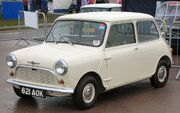
1959 Morris Mini-Minor
The original two-door Mini was a small car that was made by the British Motor Corporation (BMC) and its successors from 1959 until 2000. It is considered an icon of the 1960s,[2][6][7] and its space-saving front-wheel-drive layout (which allowed 80% of the area of the car's floorpan to be used for passengers and luggage) influenced a generation of car-makers.[8] The vehicle is in some ways considered the British equivalent to its German contemporary, the Volkswagen Beetle, which enjoyed similar popularity in North America. In 1999 the Mini was voted the second most influential car of the 20th Century, behind the Ford Model T.[9][10]
This distinctive two-door car was designed for BMC by Sir Alec Issigonis.[11][12] It was manufactured at the Longbridge and Cowley plants in England, the Victoria Park / Zetland British Motor Corporation (Australia) factory in Sydney, Australia, and later also in Spain (Authi), Belgium, Chile, Italy (Innocenti), Portugal, South Africa, Uruguay, Venezuela and Yugoslavia. The Mini Mark I had three major UK updates: the Mark II, the Clubman and the Mark III. Within these was a series of variations including an estate car, a pickup truck, a van and the Mini Moke—a jeep-like buggy. The Mini Cooper and Cooper "S" were sportier versions that were successful as rally cars, winning the Monte Carlo Rally four times from 1964 through to 1967, although in 1966 the Mini was disqualified after the finish, along with six other British entrants, which included the first four cars to finish, under a questionable ruling that the cars had used an illegal combination of headlamps and spotlights.[13] Initially Minis were marketed under the Austin and Morris names, as the Austin Seven and Morris Mini Minor, until Mini became a marque in its own right in 1969.[14][15] The Mini was again marketed under the Austin name in the 1980s.
BMW MINI[]
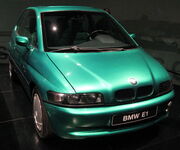
BMW E1 concept
In the 1990s, BMW was looking to broaden its model range with the addition of a compact car and SUVs. This sparked a series of compact, concept vehicles during the early 1990s. The first were the E1 and Z13, powered by an electric motor and a rear mounted 1100cc BMW motorcycle engine, respectively.[1]
In early 1994, BMW purchased the Rover Group from British Aerospace, which amongst other brands, Mini. BMW insisted that even a compact model must feature iconic BMW characteristics (such as rear wheel drive) to uphold the brands standards and image. The MINI brand, however, did not have any standards and BMW saw this as an opportunity to create a competitively-priced, yet premium, compact car. This formed BMW's plan to launch the premium BMW 1 Series and the mid-range MINI.[1]
It was at around this time that Rover, too, was working on a successor the original Mini. Its first concept was the ACV30 which was unveiled at the 1997 Monte Carlo Rally. The name was partially an acronym of Anniversary Concept Vehicle, whilst the '30' represented the 30 years that had passed since a Mini first won the Monte Carlo Rally. The vehicle itself was a 2-door coupe powered by a rear-mounted MG F engine.[1]
Just months later, Rover released another concept, this time, a pair of vehicles called Spiritual and Spiritual Too. These vehicles were a more realistic attempt to create a modern Mini, and coincided with BMW's official creation of the MINI project. Although the 2-door and 4-door pair wore Mini badges, both vehicles remained purely concepts.[1]
In 1998, BMW set out on creating the production MINI. The first aspect that was considered was the design, which was chosen from 15 full-sized design studies. Five of these designs came from BMW Germany, another five from BMW Designworks in California, four from Rover and one from an outside studio in Italy. The chosen design was from BMW Designworks and was designed by Frank Stephenson. This design, being a city car, also fitted into BMW's plan of two compact cars, leaving the supermini class for the BMW 1 Series. After the launch of the new MINI, Stephenson told automotive magazine Autocar:[1]
| “ | We wanted the first impression when you walk up to the car to be "it could only be a Mini" | ” |
—Frank Stephenson[1] | ||
Production models[]
Mini (2001-2006)[]
| It has been suggested that this section be split into a new article. (Discuss) |
[[File:  |frameless|upright=1.25|alt=]] |frameless|upright=1.25|alt=]] | |
| Production |
2001-2006 (Mk I Hardtop) 2005-2008 (Mk I Convertible) |
|---|---|
| Class | Compact |
| Body style(s) |
3-door hatchback 2-door convertible |
| Engine(s) |
1.4L Tritec I4 (One) |
| Transmission(s) |
CVT 5-speed manual 6-speed automatic and manual |
| Wheelbase | 97.1 in (2,470 mm) |
| Length |
2002-03 Base: 142.8 in (3,630 mm) 2004-06 Base & Convertible: 143.1 in (3,630 mm) S Hardtop & Convertible: 143.9 in (3,660 mm) |
| Width | 66.5 in (1,690 mm) |
| Height |
2002-03 Base: 55.9 in (1,420 mm) 2002-03 S: 56.2 in (1,430 mm) 2004-06 Base: 55.4 in (1,410 mm) 2004-06 S: 55.8 in (1,420 mm) 2004-06 Convertible: 55.5 in (1,410 mm) |
| Kerb weight | 2,496 lb (1,132 kg) |
Mini Hatch/Hardtop (2001-2006)[]
The Mini Hatch (US: Hardtop) was designed by Frank Stephenson,[16] and drew inspiration from the original Mini. The name of the new car's brand, MINI, was all-capitalised to distinguish it from its predecessor.[17] Development of the car was conducted between 1995 and 2001 by Rover Group in Gaydon, United Kingdom and BMW AG in Munich, Germany. During this development phase, there was continual contention between the two design groups, especially concerning the positioning of the car; Rover wanted a straight economy car, whilst BMW supported a small, sporting car. Ultimately, BMW prevailed, and in 1999, they assumed control over the entire project following the departure of BMW's CEO, Bernd Pischetsrieder.[18] When BMW divested itself of Rover in 2000, BMW elected to retain the Mini project, and to move the planned production site of the car from Rover's Longbridge plant,[18] to BMW's Oxford plant in Cowley, Oxford, United Kingdom. The team of designers working on the 2001 Mini had finished the full-sized clay mock-up of the Mini in plenty of time for a presentation to the board of directors. However, the chief designer, Frank Stephenson, realised that the model did not have an exhaust pipe. His short-term solution was to pick up an empty beer can, punch a hole in it, strip off the paint and push it into the clay at the back of the car, which took just a few minutes. The overall design for the mock-up was so good that the board members told him not to change a thing, resulting in the distinctive exhaust tip seen in production cars.[16]
The vehicles produced during the 2001 to 2006 model years included four hatchback models (UK and some international markets: Hatch, US: Hardtop, other markets just plain Mini): the standard "Mini One", the diesel-engined "Mini One/D", the sportier "Mini Cooper" and the supercharged "Mini Cooper S"; in 2005, a convertible roof option was added to the Mk I line-up. In November 2006, BMW released a facelift version of the Mini Hardtop as a 2007 model-year vehicle.[19]
The first new generation Mini was introduced in 2001. In many European markets, the Mini One was powered by a 1.4 litre I4[20] version of the Tritec engine but all other petrol powered Minis used the 1.6 litre I4 version.[21][22] Since 2005, a soft-top convertible option has been available across the entire range.
There are numerous styling and badging differences between the models, perhaps the most obvious being that the Cooper S has a distinctive scoop cut into the bonnet. The Cooper S also has twin exhausts which exit under the centre of the rear valance. The (non-S) Cooper has more chrome parts than the Mini One and has a single exhaust. The Mini One D has no visible exhaust pipes at all.
In some markets, such as Australia and the U.S., only the Mini Cooper and Cooper S are offered because the Mini One's engine was considered inadequate to deliver sufficient power to run an air conditioner — a necessary feature in those markets.[citation needed] Almost fifty percent of all Minis sold in Australia and about seventy percent of those sold in the U.S. are the more-powerful Cooper S model. Other models of note, sold in varying markets around the world, are the Mini Seven, Mini Park Lane, Mini Check Mate, and Mini Monte Carlo.
The names Cooper and Cooper S echo the names used for the sportier version of the classic Mini, which in turn come from the involvement of John Cooper and the Cooper Car Company. The Cooper heritage is further emphasised with the John Cooper Works (JCW) range of tuning options that are available with the Mini. John Cooper also created a one-off racing model of the Mini Cooper S named the Mini Cooper S Works. This car features many extras which help to improve performance, such as a racing exhaust and air filter as well as uprated suspension. The car also has one-of-a-kind 17-inch (430 mm) racing wheels.[23]
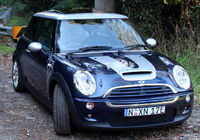
A 2006 Mini Cooper S Checkmate.
The Mk I Mini One, Cooper and Cooper S used some version of the reliable, Brazilian-built Tritec engine, co-developed by Chrysler & BMW; the Mini One D used a Toyota-built diesel engine. In August 2006, BMW announced that future engines would be built in the UK, making the car essentially British-built again; final assembly took place at Oxford, and the body pressings were made in nearby Swindon at BMW's Swindon Pressings Ltd subsidiary.
All models used a transversely-mounted four-cylinder engine driving the front wheels. All four wheels are pushed to the corners of the body to improve handling. The styling of the car, like that of the Volkswagen's New Beetle, is a retro design that is deliberately reminiscent of the original Mini. The retro styling is further enhanced by retaining other classic Mini touches such as contrasting roof colours, optional bonnet stripes, optional rally lights, and black trim around the wheel arches and rocker panels that mimic the wide wheel flares found on many classic Minis.[16]
The Mini One and Mini Cooper were available with a ZF VT1F continuously variable transmission or with a conventional Midlands five-speed manual transmission (model years 2001-2004); the latter was replaced with a Getrag five-speed unit for the remainder of the Mk I production (2005–2006). The Cooper S came with a six-speed Getrag manual or (starting with the 2005 model year) a fully automatic transmission with paddle shifters.
As standard, the Mini had a drive by wire electronic throttle, electronic brakeforce distribution, cornering brake control and electronic stability control (standard or optional, depending on model and region) to improve control and handling in adverse conditions.[24]
The addition of a supercharger to the Mk I Cooper S required that the battery be relocated into the rear of the car — leaving no room for a spare tyre; hence this model comes with run-flat tyres as standard.
Mini Convertible (2005-2008)[]
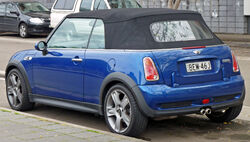
Mini Cooper S convertible, top-up
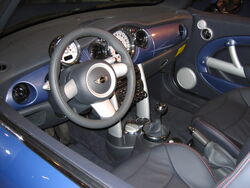
Mini Cooper Convertible, interior
At the 2004 Salon International de l'Auto, Mini introduced a convertible model which was released in the 2005 model year and available in One, Cooper and Cooper S versions.
The convertible roof is fully automatic — an unusual feature in such a small car — and can be opened partially to act as a sunroof whilst the car is driving at speed. The convertible model forsakes the rear hatchback of the Hardtop Mini, replacing it with a drop down 'tailgate' that is reminiscent of the classic Mini — it incorporates similarly prominent external hinges, and with the roof in the closed position, the rear roof section and luggage shelf can be raised with two handles, semi-tailgate style, to access the luggage space easier. The convertible also adds two small power windows for the rear seat passengers which are lowered automatically when the roof opens. The roof is made from a heavy cloth, with many layers of insulation; the rear window is glass with an integral heater/defroster, but no washer or wiper.
At the 2007 North American International Auto Show, Mini introduced the limited edition Mini Cooper S Sidewalk Convertible. It had a top speed of 215 km/h (134 mph) and accelerates from 0 to 100 kilometres per hour (0 to 62 mph) in 7.9 seconds. The engine provides 168 hp (125 kW) and 220 N·m (160 ft·lbf) of torque.
Mini John Cooper Works GP (2006)[]
The last Mk I variant to be produced using the Tritec engine was the Mini Cooper S with John Cooper Works GP Kit: a light-weight, quasi-race-prepped John Cooper Works model. Hand-finished by Bertone in Italy, it was offered as a limited-production run of 2000 cars during the 2006 model year, with 444 of those originally intended for the UK market (although ultimately, 459 were sold). The GP features more bolstered front seats but had no rear seats, which along with reduced sound-deadening, removal of the rear wash-wipe system, optional air-conditioning, and other weight-reduction steps, resulted in a weight saving of around 40 kg (88 lb) compared to a Cooper S. Additionally, the car had enhanced braking, suspension, a smooth under-body and 218 hp (163 kW) from the John Cooper Works engine modification package. In place of the rear seats there is additional body stiffening and below-floor storage areas. The car also offered many unique styling points, such as the red door mirrors, a carbon fiber rear spoiler, unique body kit, bespoke (2 kg lighter) 4-spoke alloy wheels, and specialised badging. Available in just one colour scheme (Thunder Blue with a Pure Silver roof), each car was individually numbered and featured a decal on the roof along with a plaque on the dashboard. The last of the supercharged Minis and a genuine Limited Edition model, there is a high potential for the Mini Cooper S with John Cooper Works GP Kit to become a collector's item.
Mini Mk II (2007-)[]
Mini Hatch/Hardtop (2007-)[]
- Main article: Mini Hatch (2007-)
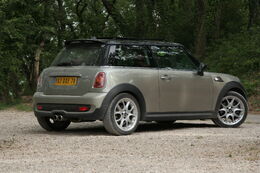
Mini Cooper S (2007+)
Mini introduced an all-new, second generation of the Hardtop/Hatch model for the 2007 model year, on a re-engineered platform incorporating many stylistic and engineering changes. It utilises the Prince engine, the architecture of which is shared with PSA Peugeot Citroën and is designed to be more cost-effective and fuel-efficient, and is manufactured at the BMW Hams Hall engine plant in Warwickshire, United Kingdom.[25] The engineering was done in the United Kingdom by BMW Group UK Engineering, in Munich, Germany at BMW Group headquarters, and by external third parties.
The so-called "Mk II Mini" (echoing the 'mark number' naming convention associated with the classic Mini) was introduced in November 2006 as a hatchback (US: Hardtop) model (internally known as the R56), in the Cooper and Cooper S trim levels; the range was completed in 2007 with the Mk II Mini One. For the first time, there was a diesel-powered Cooper, available from April 2007, and badged as the Cooper D, which was supplemented in January 2011 with a new 2.0 L diesel badged as the Cooper SD.
Though the Mk II has a familiar look, every panel on the new car was changed from the previous model. New safety requirements resulted in the overall length increasing by 60 mm (2.4 in), the front end raised and the indicators being repositioned inside the headlight housings. The headlights themselves are now fixed to the front quarter panels rather than being integrated with the bonnet, so that they are not raised up with it when the bonnet opens. The car features a restyled grille and larger rear light clusters. The Cooper S retains the bonnet scoop in order to keep an association with the outgoing model — although the relocation of the intercooler to the front of the engine means that the scoop is now purely decorative. In addition, the Cooper S no longer has the battery located under the boot floor, instead being found in the more conventional location under the bonnet. The C-pillars are no longer encased in glass and have been shaped to improve aerodynamics and to reduce the tendency for dirt to accumulate on the back of the car. Much criticised for the lack of rear legroom, Mini added more space for rear passengers by creating sculpted cut-outs in the rear of the front seats. An engine start button replaces the conventional ignition key and, with the optional 'Comfort Access', the car unlocks itself automatically when the key is brought close to the car.
Mini Clubman (2008-)[]
- Main article: MINI Clubman

Mini Clubman
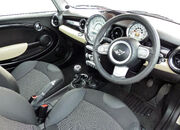
Interior of the Mini Cooper Chilli
The Mini Clubman is an estate car version of the Mini Hatch, introduced for the 2008 model year and available in One, Cooper, Cooper S, and Cooper D variations. While identical to the Hardtop from the B-pillars forward, the Clubman is 240 mm (9.4 in) longer overall, with a correspondingly stretched wheelbase that is 80 mm (3.1 in) longer; this provides more rear-seat leg room and substantially increased cargo space when compared to the Hardtop — 160 mm (6.3 in) longer, giving 260 litres (9.2 cubic feet) of space. It has twin "barn doors," alternately referred to as "the Splitdoor," enclosing the boot instead of a pull-up hatch, and also features a "Clubdoor" on the right-hand side regardless of the intended market. This means that in right-hand drive markets (including the car's home market), the rear door is on the road side of the car, requiring rear passengers to exit into the road.
Engine and transmission selections are identical to those used in the Hatch/Hardtop model, except the 66 kW (90 PS/89 hp) One Diesel; and the rear suspension set-up shares many of the same designs features including the rear trailing arms and the anti-roll bars.
The use of the name "Clubman" for the Mini estate van was a break with classic Mini tradition. "Clubman" was originally the name given to the 1970s face-lift of the classic Mini, which mostly resulted in a squared-off front end, whereas the classic Mini estates had traditionally been named "Traveller" or "Countryman". However, BMW did not initially purchase the rights to use those names.
Mini John Cooper Works Challenge (2008-)[]
The Mini John Cooper Works Challenge is a purpose-built race car, based on the R56 Hardtop, and manufactured in the BMW Motorsport factory located in Munich. The BMW Motorsport factory has been responsible for the construction of Formula One and European touring cars for many years. The R56 Challenge features a 6-speed manual transmission; 17-inch Borbet wheels with Dunlop control slick racing tyres; John Cooper Works aerodynamic kit including front splitter, rear diffuser, and high-downforce, adjustable rear wing; race-specific AP Racing ABS braking system; KW suspension rebound; height- and camber-adjustable coilover suspension; full roll cage; Recaro bucket seat with 6-point safety belt; HANS device; Sparco racing steering wheel; air jack system; and a fully-electronic fire extinguishing system.
The car features a 1.6-litre, twin-scroll turbocharged engine that produces 155 kW (211 PS/208 hp) at 6000 RPM, along with 261 N·m (193 lb·ft) of torque. Acceleration from 0–100 km/h (60 mph) is claimed at 6.1 seconds, and braking time from 100–0 km/h is just 3.1 seconds. It has MSRP of €49,900.
The R56 Challenge was unveiled in 2007 at the IAA Motor Show.[26]
Mini Convertible (2009-)[]
- Main article: Mini Convertible (2009-)
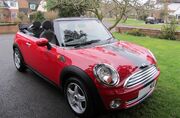
2009 Mini Cooper convertible
The Mk II Mini Cooper Convertible was unveiled at the 2009 Detroit Auto Show[27] and the 2009 Geneva International Motor Show[28] as a 2009 model-year vehicle (first available for sale on 28 March 2009[29]). A device, marketed as the "Openometer", records the number of minutes the vehicle has operated with its roof retracted. Available variants and corresponding powertrain selections are the same as in the other Mk II Mini models, including the diesel engine in some markets.
Mini John Cooper Works (2009-)[]
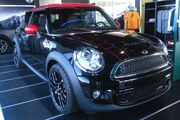
Mini John Cooper works model year 2011
Loosely based on the John Cooper Works (JCW) Challenge car, these are essentially Mk II Cooper S vehicles with a higher-output engine; a low-back-pressure exhaust system; a stiffer sport suspension; 17-inch light alloy rims with low-profile, performance tyres; Brembo performance brakes; and BMW's dynamic stability control (DSC) and Dynamic Traction Control (DTC) with Electronic Differential Lock Control (EDLC) as standard equipment. All JCW models are only available with a specific 6-speed Getrag manual transmission, and come with distinctive "John Cooper Works" badging in place of the normal "Cooper S" badging. The JCW vehicles are also factory-built, which further distinguishes them from earlier Mk II Cooper S models with any of the available John Cooper Works accessories (engine and suspension upgrades, aerodynamics kit, etc.) that are dealer-installed.
The available JCW body styles are referred to as "John Cooper Works Hardtop," "John Cooper Works Clubman," or "John Cooper Works Convertible," reflecting the corresponding Cooper S body styles. All JCW models achieve the same EPA fuel economy ratings as their Cooper S counterparts.[30]
The engine is rated at 211 PS (155 kW/208 hp) and 261 N·m (193 lb·ft); under heavy acceleration, the engine automatically boosts torque output to a peak of 279 N·m (206 lb·ft). These figures are achieved by reducing compression ratio to 10.0:1, and increasing boost from 0.9 bar (13 psi) to 1.3 bar (19 psi) when compared to the turbocharged engine used in the Cooper S.[31] According to Mini, the JCW Hardtop will sprint to 60 mph (97 km/h) in 6.2 seconds, with the JCW Clubman clocking in at 6.5 seconds; both vehicles top out at 147 mph (237 km/h).
The JCW variants were unveiled in 2008 at the Geneva Auto Show, as 2009 model-year vehicles.[32]
Mini John Cooper Works World Championship 50 (2009)[]
This is a limited-edition (originally planned to be 250 units, then subsequently increased to 500) of the John Cooper Works Hardtop. It commemorates the 50th Anniversary of the Formula One World Championship title won by John Cooper (builder) and Jack Brabham (driver).
The production vehicle was inspired by John Cooper's son, Mike. It includes the John Cooper Works aerodynamics package; John Cooper Works Cross Spoke Challenge light-alloy wheels in Jet Black; specific body paint colours (Connaught Green body with Pepper White roof and bonnet stripes), carbon fibre bonnet scoop, rear diffuser, exterior mirror caps and tailgate handle; and specific interior colour scheme (Carbon Black interior with red knee-rolls, armrests and red stitching on the floor mats, gearshift & handbrake gaiters). The John Cooper signature was provided by "John" Michael Cooper.
The car was unveiled in 2009 Mini United Festival in Silverstone.[33]
Mini E (2009-)[]
- Main article: Mini E
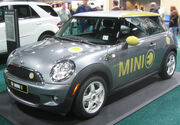
Mini E electric car
The Mini E is a front-wheel drive electric car powered version of the Mini and was unveiled in 2008 at the Los Angeles Auto Show,[34] with an electric motor rated 204 PS (150 kW/201 hp) and 220 N·m (160 lb·ft), 380V 35 kilowatt-hours (130 MJ) lithium-ion battery with distance of 240 kilometres (150 mi). It has top speed of 152 km/h (94 mph). The vehicle gliders are built in the Mini factory in Oxford, while batteries, electric drive and power electronics are manufactured in Munich. The components are then shipped to a specially-equipped manufacturing complex, situated on BMW plant premises where the electric motor, battery units, performance electronics and transmission can be integrated.[35]
The Mini E is a demonstration car part of BMW's "Project i", which will be followed in mid 2011 by a similar trial with the BMW Active E all-electric vehicle, which will be built based on the lessons learned from the Mini E field testing. The last phase of "Project i" is the development of the Mega City Vehicle (MCV) urban electric car, a new brand that will be sold separately from BMW or Mini, and is expected to go into mass production between 2013 and 2015.[36][37][38][39] Field testing began in June 2009 and 450 Mini E were made available through leasing to private users in Los Angeles and the New York/New Jersey area.[40] In May 2010 BMW announced that leasing could be renewed for another year at a lower leasing price.[38][41] Another field test was launched in the U.K. in December 2009, where more than forty Mini E cars were handed to private users for a two consecutive six-month field trial periods.[42] Additional field testing is taking place in Germany and France.[36][43][44][45] This trial program allowed the BMW Group to become the world's first major car manufacturer to deploy a fleet of more than 500 all-electric vehicles for private use.[46]
Electric conversion options[]
US company Li-ion Motors, previously Hybrid Technologies, sells an all-lithium, electric-powered Mini Cooper conversion[47] for an estimated $65,000[48] called LiV Flash. The electric Mini uses proprietary lithium management and battery-balancing system. Top speed is only around 80 mph (130 km/h) but driving at a slower speed preserves battery-life and means owners will be able to travel up to 120 miles (190 km) on a single charge.[49]
EV Television (EVTV.ME) is publishing a series of videos documenting their conversion of a 2009 Mini Cooper Clubman to electric drive. The project uses a more powerful AC induction motor from MES-DEA and TIMS600 controller to provide 177 lb·ft (240 N·m) of torque. It uses 112 readily available Sky Energy 100Ah LiFePO4 cells to provide an energy storage of 40.3 kWh, a range of 125 miles (201 km), and a top speed of 120 mph (190 km/h).[citation needed]
Mini Countryman (2010-)[]
- Main article: Mini Countryman
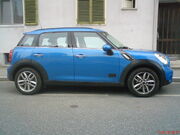
Mini Countryman
In January 2010, Mini unveiled the Countryman (internally, the R60), a crossover SUV – for model year 2011. The Countryman features five doors; a longer wheelbase, more interior room than the Clubman, higher ground clearance, the same range of engines as other models, and optional all-wheel-drive powertrain (dubbed "ALL4").[50]
Engine summary[]
| Model | Years | Type | Power, torque @ rpm |
|---|---|---|---|
| Petrol engines | |||
| First | 2009–2010 | 1,397 cc (1.397 L/85.3 cu in) I4 | 75 PS (55 kW/74 hp) @ 4500, 120 N·m (89 lb·ft) @ 2500 |
| One | 2007–2010 | 1,397 cc (1.397 L/85.3 cu in) I4 | 95 PS (70 kW/94 hp) @ 6000, 140 N·m (100 lb·ft) @ 4000 |
| First | 2010- | 1,598 cc (1.598 L/97.5 cu in) I4 | 75 PS (55 kW/74 hp) @ 6000, 140 N·m (100 lb·ft) @ 2250 |
| One | 2010- | 1,598 cc (1.598 L/97.5 cu in) I4 | 98 PS (72 kW/97 hp) @ 6000, 153 N·m (113 lb·ft) @ 3000 |
| Cooper Hardtop Cooper Clubman Cooper Convertible |
2007–2010 2008-2010 2009-2010 |
1,598 cc (1.598 L/97.5 cu in) I4 | 120 PS (88 kW/120 hp) @ 6000, 160 N·m (120 lb·ft) @ 4250 |
| Cooper (all body styles) | 2010- | 1,598 cc (1.598 L/97.5 cu in) I4 | 122 PS (90 kW/120 hp) @ 6000, 160 N·m (120 lb·ft) @ 4250 |
| Cooper S Hardtop Cooper S Clubman Cooper S Convertible |
2007- 2008- 2009- |
1,598 cc (1.598 L/97.5 cu in) I4 turbo | 175 PS (129 kW/173 hp) @ 5500, 240 N·m (180 lb·ft) @ 1600-5000
Overboost: 260 N·m (190 lb·ft) @ 1700-4500 |
| Cooper S (all body styles) | 2010- | 1,598 cc (1.598 L/97.5 cu in) I4 turbo | 184 PS (135 kW/181 hp) @ 5500, 240 N·m (180 lb·ft) @ 1600-5000
Overboost: 260 N·m (190 lb·ft) @ 1700-4500 |
| John Cooper Works CHALLENGE John Cooper Works (all body styles) |
2008- 2009- |
1,598 cc (1.598 L/97.5 cu in) I4 turbo | 211 PS (155 kW/208 hp) @ 6000, 261 N·m (193 lb·ft) @ 1850-5600
Overboost: 279 N·m (206 lb·ft) @ 2000 |
| Diesel engines | |||
| One D | 2007–2009 | 1,364 cc (1.364 L/83.2 cu in) I4 turbo | 88 PS (65 kW/87 hp) @ 4000, 190 N·m (140 lb·ft) @ 1750 |
| One D | 2009–2010 | 1,560 cc (1.56 L/95 cu in) I4 turbo | 90 PS (66 kW/89 hp) @ 4000,88 hp |
| Cooper D | 2008–2010 | 1,560 cc (1.56 L/95 cu in) I4 turbo | 110 PS (81 kW/110 hp) @ 4000, 240 N·m (180 lb·ft) @ 1750-2000
Overboost: 260 N·m (190 lb·ft) |
| One D | 2010- | 1,598 cc (1.598 L/97.5 cu in) I4 turbo | 90 PS (66 kW/89 hp) @ 4000, 215 N·m (159 lb·ft) @ 1750-2500 |
| Cooper D | 2010- | 1,598 cc (1.598 L/97.5 cu in) I4 turbo | 112 PS (82 kW/110 hp) @ 4000, 270 N·m (200 lb·ft) @ 1750-2250 |
| Electric motors | |||
| E | 2009- | AC Propulsion 13000 rpm motor, 100A @ 13.5 V power supply |
204 PS (150 kW/201 hp) @ 6000-12000, 225 N·m (166 lb·ft) @ 0-5000
Regeneration: 115 N·m (85 lb·ft) |
Production[]
Before BMW's ownership, the traditional Mini had been made at both Cowley, Oxfordshire and Longbridge, Birmingham. In time, production was rationalised to just Longbridge and so this was where the last of the cars were made, making Longbridge the "natural home" for the new Mini prior to BMW splitting up the company. However, as a result of the change of ownership, BMW retained just the Cowley plant, and renamed this "plant Oxford", on the site of what was historically the Pressed Steel Company body plant and next door to what was historically the Morris factory.[51]
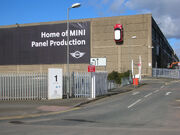
Plant Swindon
Since 2006, Plant Hams Hall produces the new Mini petrol engines, Plant Oxford is responsible for the body shell production, paint and assembly, and Plant Swindon produces body pressings and sub-assemblies, creating the "Mini Production Triangle".[52] Mini claim that 60% of components of the Mini Mk II come from suppliers based in the UK compared to 40% for the 2001 model. The Countryman is the first modern Mini assembled outside the UK, with the contract won by Magna Steyr in Austria.[5]
At Plant Oxford 4,000 employees, referred to as 'associates', produce up to 800 cars each day (approximately 240,000 per year).[53] The bodyshop at Cowley holds 429 robots, assembling 425 body panels; the bodyshells are then moved to the neighbouring paint shop where paint robots apply the 14 exterior colour options and optional contrasting roof colours. Final assembly is performed at Cowley, which involves the fitting of 2,400 components to produce the numerous variants that may be ordered.[54][55]
All Prince four-cylinder petrol engines for Mini and BMW are produced at the Hams Hall Plant[56] near Birmingham, United Kingdom, which has around 800 employees.[57] Diesel engines are manufactured by BMW's Plant Steyr in Austria, having previously been manufactured in France and England by PSA.
Mini sub-assemblies and pressings such as doors are supplied by the plant at Swindon, where 1,000 are employed and 280 pressed parts are produced using 135 welding robots.[58] The Swindon plant was originally Swindon Pressings Ltd, founded in 1955 by the Pressed Steel Company and became a wholly owned subsidiary of the BMW Group May 2000.[59]
Minis are primarily developed in the United Kingdom by BMW's Development Division.[60]
Sales[]
A total of around 5.3 million of the original two-door Minis were sold, making it by far the most popular British car of all-time. Thousands of these are still on the road, with the remaining pre-1980s versions being firmly established as collectors' items.
Deliveries of Minis has ranged from 188,077 in 2006 to 232,425 in 2008. In 2009 216,538 cars were delivered,[61] with 69.3% being Mini Hatch/Hardtop, 13.1% Convertible models and 17.6% the Clubman variant. Over 53% were the Cooper version, with 26.2% Cooper S, and the basic One 20.2%.[62]
In November 2008, BMW announced to close its Oxford factory for four weeks to cut production as sales rapidly deteriorated. Sales of the Mini in Britain plunged 40 per cent in October against a fall of 23 per cent in the overall market.[63]
In 2009, the Mini was Britain's seventh best selling car - the first time that a BMW-era Mini had appeared among the nation's top 10 selling cars.[64] It also was Britain's seventh best selling car in June 2010.[65]
Internal designations[]
All Mini models have R-series model numbers assigned to them, a legacy of the Mini's original development within Rover Group. The following designations are known:[66]
- R50: "Mk I" Mini One & Cooper (2001–2006)
- R52: "Mk I" Mini Convertible (2004–2008)
- R53: "Mk I" Mini Cooper S (2001–2006)
- R55: "Mk II" Mini Clubman and D (2007–present)
- R56: "Mk II" Mini Hatch/Hardtop range (2006–present)
- R57: "Mk II" Mini Convertible (2009–present)
- R58: Coupé (not yet launched)[67]
- R59: Roadster (not yet launched)
- R60: Countryman (2010–present)
- R61: Paceman (not yet launched)[68]
Body type summary[]
| Chassis codes | R55 | R56 | R57 |
|---|---|---|---|
| Body styles | Clubman | Hardtop | Convertible |
| Engine | Years | ||
| First | - | 2009- | - |
| One | - | 2007- | - |
| Cooper | 2008- | 2007- | 2009- |
| Cooper S | 2008- | 2007- | 2009- |
| John Cooper Works | 2009- | 2009- | 2009- |
| John Cooper Works Challenge | - | 2008- | - |
| Cooper D | 2008- | 2008- | 2008- |
| E | - | 2009- | - |
Concept cars[]
9X (1967 to 1979)[]
From 1967 to 1979, Alec Issigonis worked on designing a replacement for the Mini in the form of an experimental model called the 9X.[11][12] The 9X was longer and more powerful than the original Mini, but due to politicking inside British Leyland (which had now been formed by the merger of BMC's parent company British Motor Holdings and the Leyland Motor Corporation), the car never reached production.[11]
ACV30 (1997)[]
Rover first showed its ideas for a modern Mini in the form of the ACV30 concept car in 1997 created to celebrate the 30th anniversary of Mini's win at the 1967 Monte Carlo Rally.[69]
Based on the mid-engined, rear wheel drive MGF,[70] the ACV30 featured several elements that influenced the eventual new Mini of 2001 such as the black a-pillars, chunky wheel arch detailing and white roof. The concept was attributed to the BMW designer Adrian van Hooydonk[71] and Frank Stephenson.
2000 Paris Auto Show[]
Before the first sales of the new generation Mini in 2001, prototype versions were shown at the 2000 Paris Auto Show. These were essentially identical to the version that was finally sold except that the colours used ('Candy Blue' and 'Flamenco Orange') have never been used in production.
Alternative fuel versions[]
BMW demonstrated a hydrogen-powered internal combustion technology in some of their concept cars in 2000 and 2001, and Mini showcased a hydrogen-powered concept car in 2001 at the Frankfurt Auto Show. The car differs from electric-motor hydrogen concepts, such as the Honda FCX in that it uses a cylinder-based internal combustion engine.
An all-electric Mini is in use at the British Embassy in Mexico that uses around 200 kilograms (440 lb) of Lithium Ion batteries.[citation needed] Three electric Minis were also made for use in some subway scenes in the 2003 movie The Italian Job to satisfy the subway authorities concerns over possible carbon monoxide poisoning.[citation needed]
PML Flightlink developed a prototype series-hybrid conversion, called "Mini QED", replacing the drivetrain with an 160 bhp (120 kW) electric motor in each wheel and an efficient on-board petrol generator.[72]
Mini Traveller (2005)[]
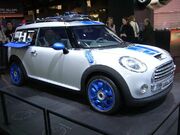
Mini Traveller concept car at the 2006 Detroit Auto Show
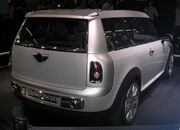
Mini Traveller rear view
At the 2005 Frankfurt Motor Show Mini revealed a retro version of the classic "Mini Traveller" estate car. The Traveller concept had a stretched wheelbase, two side-hinged rear doors, and separate rear seats replacing the split bench seat of the standard Mini. At the Tokyo Auto Show, the same basic concept reappeared with some fanciful additions — a circular roof section that could be removed to form a picnic table with four folding chairs. The rear side windows were replaced with fold-down storage containers containing cutlery, cups and plates. A further version was presented at the Detroit without the table and chairs but with a radically restyled interior. Ultimately, a production version of the Traveller concept vehicle appeared during the 2008 model year as the Mini Clubman.
Mini Crossover (2008)[]
The Mini Crossover Concept was unveiled in 2008 at the Paris Motor Show.[73] It was over 4 metres (13 ft) long, with four-wheel drive, wide tyres, and a single piece rear door with a retractable rear window. Inside, it had a large glass ball in the centre of the instrument panel, called the 'Mini Centre Globe'; this system incorporated laser projection technology for 3D navigational routes and films. A production vehicle based on the Crossover Concept was launched in 2010 as the Mini Countryman.
Mini Coupé (2009)[]
This was a 2-seat concept vehicle, unveiled in 2009 at the Frankfurt Motor Show,[74] and inspired by the classic Mini. As its name suggests, it had a coupé body, used the engine from the John Cooper Works vehicles, and had the chrome radiator grille from the Cooper S (but with the inner sections of the grille finished in the body colour). It had a luggage capacity of 250 litres.
BMW AG subsequently announced that a production version would be built in Oxford. Likely model year introduction would be 2011, with possible engine choices to include the 1.6-litre turbo from the John Cooper Works vehicles.[75]
Mini Beachcomber (2009)[]
- Main article: MINI Beachcomber
On 16 December 2009, Mini revealed the Beachcomber Concept, which drew heavily on the Moke styling while still being packed with modern equipment. The Beachcomber Concept was based on the forthcoming Countryman all-wheel drive platform, and made its public debut at the Detroit Auto Show in January 2010.[76]
Mini Paceman (2011)[]
The three-door Paceman concept was announced in January 2011 at the Detroit Auto Show, Mini's 10th anniversary in the US market. Designed by Gert Hildebrand,[77] it was based on the recently launched Countryman, with a similar interior, and range of options and drivetrains, including the ALL4 permanent all-wheel drive system.[78] From the screen rearwards, the Paceman features an entirely new exterior borrowing design features of the 2009 Mini Coupe Concept[79] and is 4110mm long.
The concept car was shown with the most powerful engine in the Mini range: the John Cooper Works 1.6-litre twin-scroll turbocharged engine, with 211 hp and maximum torque of 260 Nm, with an overboost maximum of 280 Nm. Production was mooted to commence in 2012, and Mini's marketing materials referred to it as the first "Sports Activity Coupe".[80]
Mini Rocketman (2011)[]
The Mini Rocketman concept was announced in February 2011 and will be unveiled at the Geneva Motor Show. This will be a three-door hatchback, about a foot shorter than the current model, with a panoramic glass roof etched with the Union Flag.[81] It is not much bigger than the original Mini, and has unusual doors. Constructed by carbon spaceframe, Mini said that the Rocketman can do 94mpg, on average. Yahoo! described the Rocketman as 'the weirdest concept Mini yet'.[82]
Marketing[]
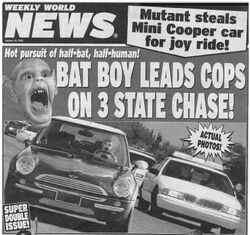
Mini paid for this Weekly World News story as a part of an advertising campaign in 2003
During the production of first generation Mini, as a joke and undoubtedly as a part of Mini's viral marketing approach, purchasers of the Mini convertible were asked to sign a "contract" promising that they would drive the car with the roof open at least 90% of the time. Mini also set up a telephone hotline (in the USA: 1-888-DO NOT CLOSE) which one may call to report convertible owners who are driving with the roof up inappropriately. The automated system offers such helpful advice as how to administer a wedgie to the offender.
Butler, Shine, Stern & Partners, Mini's advertising agency, produced a video series called Hammer & Coop, directed by Todd Phillips as part of an ad campaign for the Mini.[83]
Crispin Porter + Bogusky, Mini's advertising agency, produced a movie called Counterfeit Mini Coopers as part of the ad campaign.[84]
To advertise Mini Clubman's introduction to Chinese market, Beijing Mini offered a Mini Rickshaw, which uses the rear half of Mini Clubman.[85]
In New Zealand, Mini sponsored Mad Men, broadcast on Prime. Special spots were created; for the first season, these took the form of a satirical, sexist 60s-style television commercial. For the second season, the spot was a pastiche of Mad Men's opening credits, with a silhouette figure tumbling out of an office building, landing in the driver's seat of a Mini.
Motorsport[]
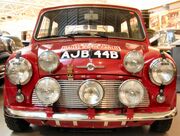
1965 Monte Carlo Rally winner: 1964 Morris Mini Cooper S
The Mini Cooper S won the Monte Carlo Rally in 1964, 1965 and 1967.[86] Minis were initially placed first, second and third in the 1966 rally as well, but were controversially disqualified for the use of a variable resistance headlamp dimming circuit in place of a dual-filament lamp.[87]
An R56 Challenge vehicle was entered in the 2008 Mini Challenge.[88] The Mini Challenge Motorsport Category runs globally, with the categories in Germany, Australia, England, Spain, New Zealand, and Saudi Arabia commencing in 2010.
RSR Motorsports has entered three Mini Coopers in the KONI Challenge Series Street Tuner class.[89]
Mini Countryman WRC[]
- Main article: Mini Countryman WRC
On 27 July 2010 Mini announced plans to enter the World Rally Championship.[90] The Countryman is the chosen donor model and Prodrive have been selected to prepare the Mini Countryman WRC. The factory team will compete in a reduced programme for the 2011 WRC season, before taking on the full calendar in 2012.
Awards and criticism[]

Mini owners were invited to bring their cars to the world premiere of The Italian Job
The original two-door Mini has won numerous awards, perhaps the most notable being: "Car of the Century" (Autocar magazine 1995), "Number One Classic Car of All Time" (Classic & Sports Car magazine 1996) and "European Car of the Century" in a worldwide Internet poll run by the prestigious Global Automotive Elections Foundation in 1999. The original Mini achieved second place for "Global Car of the Century" in the same poll (behind the Model T Ford).
The Mini Cooper/Cooper S (2001-2006) won the North American Car of the Year award in 2003.[91] Following the launch of the Mk II Mini, Top Gear named the new Cooper S their Small Car of the Year 2006.[92] In 2008 the green version of the Mini, the Mini Cooper D, was nominated for WhatGreenCar.com Car of the Year Awards. The judges commended the Cooper D for its EfficientDynamics stop-start and regenerative braking technology and were impressed by the car's driving experience. The Cooper D reached the shortlist for the Green Car Awards, but lost to the Ford Focus ECOnetic. In April 2010 Kelley Blue Book included the Mini Cooper as one of its Top 10 Green Cars for 2010.[93][94]
Dr. Alex Moulton, the designer of the suspension system for the original two-door Mini, spoke about the new Mini in an interview with MiniWorld magazine: "It's enormous - the original Mini was the best packaged car of all time - this is an example of how not to do it. It's huge on the outside and weighs the same as an Austin Maxi. The crash protection has been taken too far. I mean, what do you want, an armoured car? It is an irrelevance insofar as it has no part in the Mini story."[95]
The Pulitzer Prize-winning automotive journalist Dan Neil has suggested that, with the introduction of the Countryman, Mini had pushed the marque beyond relevance by making a car so long, wide and tall it forsook the inner logic of the brand: excellent handling in a tiny size.[96]
References[]
- ↑ 1.0 1.1 1.2 1.3 1.4 1.5 1.6 Laban, Brian (2003). The mini : the making of a modern icon, Updated ed, London: Collins. ISBN 0-00-715275-2.
- ↑ 2.0 2.1 2.2 2.3 Reed, Chris (1994). Complete Mini: 35 Years Of Production History, Model Changes, Performance Data. Croydon: MRP. ISBN 0-947981-88-8.
- ↑ "New Mini: Retro in a Smaller Role", The New York Times (15 September 2000). Retrieved on 21 November 2010.
- ↑ "Millionth Mini produced in Oxford", BBC News (4 April 2007). Retrieved on 21 November 2010.
- ↑ 5.0 5.1 "Mini Countryman (2010): first official pictures". Car Magazine. Retrieved on 2 February 2011.
- ↑ Reed, Chris (2003). Complete Classic Mini 1959-2000. Orpington: Motor Racing. ISBN 1-899870-60-1.
- ↑ Clausager, Anders (1997). Essential Mini Cooper. Bideford, Devon: Bay View Books. ISBN 1-870979-86-9.
- ↑ Martin Buckley & Chris Rees (2006). Cars: An encyclopedia of the world's most fabulous automobiles. Hermes House. ISBN 1-84309-266-2. “The BMC Mini, launched in 1959, is Britain's most influential car ever. It defined a new genre. Other cars used front-wheel drive and transverse engines before but none in such a small space.”
- ↑ "This Just In: Model T Gets Award", James G. Cobb, The New York Times, December 24, 1999
- ↑ Strickland, Jonathan. "HowStuffWorks "How the MINI Cooper Works"". Auto.howstuffworks.com. Retrieved on 2010-07-20.
- ↑ 11.0 11.1 11.2 Wood, Jonathan (2005). Alec Issigonis: The Man Who Made the Mini. Breedon Books Publishing. ISBN 1-85983-449-3.
- ↑ 12.0 12.1 Nahum, Andrew (2004). Issigonis and the Mini. Icon Books. ISBN 1-84046-640-5.
- ↑ "Future of Monte Carlo rally in doubt", BBC (21 January 1961).
- ↑ Michael Sedgwick & Mark Gillies, A-Z of Cars 1945-1970, 1986
- ↑ Adams, Keith; Ian Nicholls. "Mini development story Pt.2". AROnline.
- ↑ 16.0 16.1 16.2 Paterick C. Paternie. Mini. ISBN 0-7603-1157-9. Cite error: Invalid
<ref>tag; name "paternie" defined multiple times with different content - ↑ "BMW Operations and Production: Can you tell me more about the Mini?". BMW. Retrieved on 2006-05-01.
- ↑ 18.0 18.1 "Anglo-German Success". The Unofficial Austin-Rover Web Resource. Retrieved on 2007-01-29.
- ↑ "Introducing the 2007 Mini Cooper S", MC2 Magazine (Barry Brazier) (5). November 2006.
- ↑ Evo Magazine December 2007
- ↑ Martynn Randall. (2005). MINI Owners Workshop Manual July 2001 to 2005 (Y to 05 reg) Petrol. Sparkford: Haynes.
- ↑ (2004) Mini Cooper: service manual, Mini Cooper, Mini Cooper S, 2002, 2003, 2004.. Cambridge, MA: BentleyPublishers.com. ISBN 0-8376-1068-0.
- ↑ Gary Anderson; Don Racine (1982). Motoring: Getting the Maximum from Your New MINI. Los Altos, Calif.: Enthusiast Publications. ISBN 0-9765780-0-X.
- ↑ Tim Mundy (2004). You & Your New MINI: Buying, Enjoying, Maintaining, Modifying. Somerset: Haynes. ISBN 1-84425-028-8.
- ↑ Evo Magazine December 2006
- ↑ Nunez, Alex (2007-08-14). "Frankfurt Preview: Mini's track-prepped John Cooper Works Challenge". Autoblog.com. Retrieved on 2010-11-17.
- ↑ Nunez, Alex (2009-01-11). "Detroit 2009: Mini Cooper Convertible chills out". Autoblog.com. Retrieved on 2010-11-17.
- ↑ Joseph, Noah (2009-02-10). "Geneva Preview: Mini drops the top on the JCW cabrio". Autoblog.com. Retrieved on 2010-11-17.
- ↑ "2009 Mini Convertible Photos and Specs Released". Wot.motortrend.com. Retrieved on 2010-11-17.
- ↑ Mini fuel economy comparison
- ↑ "First Drive: 2009 Mini John Cooper Works". Motortrend.com (2007-02-26). Retrieved on 2010-11-17.
- ↑ Riches, Erin (2008-03-04). "2009 Mini John Cooper Works: 2008 Geneva Auto Show". Blogs.edmunds.com. Retrieved on 2010-11-17.
- ↑ Paukert, Chris (2009-10-06). "Officially Official: Mini Cooper JCW World Championship 50 details and photos released". Autoblog.com. Retrieved on 2010-11-17.
- ↑ Abuelsamid, Sam (2008-11-18). "LA 2008: Live reveal of the Mini E". Green.autoblog.com. Retrieved on 2010-11-17.
- ↑ Abuelsamid, Sam (2008-10-18). "LA Preview: Officially, official: the Mini E!". Autobloggreen.com. Retrieved on 2010-11-17.
- ↑ 36.0 36.1 Tom Murphy (2010-05-19). "Mini E Only Beginning of BMW EV Strategy". Wards Auto. Retrieved on 2010-06-13.
- ↑ Joe Lorio (May 2010). "Green: Rich Steinberg Interview". Automobile Magazine. Retrieved on 2010-06-12.
- ↑ 38.0 38.1 "Mini Says Half of Last Year's Mini E Lessees Renewed for Another Year". Edmunds.com (2010-05-12). Retrieved on 2010-06-12.
- ↑ Phil Patton (2010-07-03). "Envisioning a Small Electric BMW for the World’s Very Big Cities", New York Times. Retrieved on 2010-07-03.
- ↑ "BMW and UC Davis Partner on MINI E Study". Green Car Congress (2009-08-14). Retrieved on 2009-12-25.
- ↑ "Half of Mini E lessees renew for another year, price dropped to $600/month". AutoblogGreen (2010-05-14). Retrieved on 2010-06-12.
- ↑ "BMW Delivers 40 Electric MINI E Cars for UK Trial". Green Car Congress (2009-12-14). Retrieved on 2009-12-25.
- ↑ Zaher Karp (May 2010). "Upcoming Munich MIni E Trial". PluginCars.com. Retrieved on 2010-06-12.
- ↑ Chris Wright (2010-06-03). "UK: Harsh winter provides valuable Mini EV feedback". Just Auto. Retrieved on 2010-06-13.
- ↑ Jim Motavalli (2010-05-19). "BMW’s Hybrid Future May Include 3 Series". New York Times. Retrieved on 2010-06-13.
- ↑ Peter Whoriskey (2009-12-24). "Recharging and other concerns keep electric cars far from mainstream", Washington Post. Retrieved on 2009-12-25.
- ↑ Li-Ion official website
- ↑ MSN Autos
- ↑ "All-lithium electric Mini Cooper enters production - MotorAuthority - Car news, reviews, spy shots". MotorAuthority. Retrieved on 2009-06-19.
- ↑ "The MINI Countryman, Fun has no Limits". Automoblog.net.
- ↑ Gillian Bardsley, Stephen King (2006). Making Cars at Cowley. Tempus Publishing. ISBN 0-7524-3902-2.
- ↑ Mini Production Triangle official website
- ↑ "Agency posts axed at Oxford's Mini plant", BBC News (15 September 2010). Retrieved on 5 February 2011.
- ↑ "The Mini Production Triangle in the UK" - BMW Mini publicity leaflet
- ↑ "Mini Production Triangle and Oxford Plant Tour", Paultan.org, October 16, 2006
- ↑ [1]
- ↑ "German Ambassador visits Hams Hall engine plant", Birmingham Post (13 November 2009). Retrieved on 21 November 2010.
- ↑ "About 100 jobs to go at Swindon Mini plant", BBC News (9 February 2010). Retrieved on 21 November 2010.
- ↑ BMW Group website
- ↑ "Contact and FAQs". Mini USA. Retrieved on 20 December 2010.
- ↑ "BMW Chief Plans ‘Big Push’ to Fend Off Audi, Mercedes", BloombergBusinessweek (7 September 2010). Retrieved on 21 November 2010.
- ↑ BMW Group Annual Report 2009
- ↑ Christine Buckley (2008-11-07). "BMW puts the brakes on production of the Mini as sales of new cars plummet", Times of London.
- ↑ "Ford Fiesta is top in 09". Car Dealer Magazine (2010-01-08). Retrieved on 2010-05-13.
- ↑ "British car sales up 20% in a year | The Sun |News". The Sun (2010-07-06). Retrieved on 2010-08-05.
- ↑ "Mini Product Numbering System Explained". MotoringFile. Retrieved on 2007-01-29.
- ↑ Motoringfile.com 21 January 2011
- ↑ Bimmer Today 10 January 2011
- ↑ [2]
- ↑ Auto Express May 2009
- ↑ Car Design News 3 February 2009
- ↑ Hybrid electric cars, electric cars UK, electric vehicle conversions, hybrid motor vehicles[dead link]
- ↑ Lavrinc, Damon (2008-09-09). "Paris Preview: 2010 Mini Crossover Concept". Autoblog.com. Retrieved on 2010-11-17.
- ↑ "Official Debut: Mini Coupe Concept". Bmwblog.com. Retrieved on 2010-11-17.
- ↑ Abuelsamid, Sam (2009-03-09). "BMW confirms Mini coupe and another car headed for production in Oxford". Autoblog.com. Retrieved on 2010-11-17.
- ↑ "Mini Beachcomber Concept". AUSmotive.com. Retrieved on 2010-11-17.
- ↑ Autocar 10 January 2011
- ↑ Top Gear 10 January 2011
- ↑ Motor Trend 27 December 2010
- ↑ Mini UK press release December 2010
- ↑ The mini Mini: 4ft 7in high smaller model goes back to its origins
- ↑ http://uk.cars.yahoo.com/23022011/36/mini-rocketman-touches-0.html Yahoo! - Mini Rocketman touches down
- ↑ Filipponio, Frank (2007-02-20). "Hammer & Coop: Episodes 1 & 2". Autoblog.com. Retrieved on 2009-06-19.
- ↑ "Video: Counter Counterfeit Mini Coopers". Theory.isthereason.com (2005-10-29). Retrieved on 2010-11-17.
- ↑ Korzeniewski, Jeremy (2008-08-08). "Mini Clubman Rickshaws running around Beijing". Autoblog.com. Retrieved on 2010-11-17.
- ↑ "Monte Carlo Automobile Club". Acm.mc. Retrieved on 2010-10-11.
- ↑ Browning, Peter (1971). The Works Minis. Henley on Thames: Foulis. ISBN 0-85429-128-8.
- ↑ More Information[dead link]
- ↑ "Event Information - Entry List". Grand-am.com (2009-06-03). Retrieved on 2009-06-19.
- ↑ "MINI confirms WRC entry from 2011". AUSmotive.com.
- ↑ Graham Robson (2002). New Mini. Newbury Park, Calif.: Haynes North America. ISBN 1-85960-874-4.
- ↑ Top Gear 10 December 2006
- ↑ "KBB Green: Top 10 Green Cars for 2010". Kelley Blue Book (April 2010). Retrieved on 2010-05-02.
- ↑ "KBB's green cars list includes VW Golf TDI, Chevy Tahoe hybrid", USA Today (2010-04-20). Retrieved on 2010-05-02.
- ↑ "Alex Moulton". MiniWorld. Retrieved on April 24, 2006.
- ↑ "What Part of 'Mini' Did You Not Grasp, BMW?". The Wall Street Journal, March 4, 2011, Dan Neil.
External links[]
Video clips[]
| Mini · Cooper Car Company · BMW Mini · Mini Moke · vehicle timeline, 1959–present | |||||||||||||||||||||||||||||||||||||||||||||||||||||||||||||
|---|---|---|---|---|---|---|---|---|---|---|---|---|---|---|---|---|---|---|---|---|---|---|---|---|---|---|---|---|---|---|---|---|---|---|---|---|---|---|---|---|---|---|---|---|---|---|---|---|---|---|---|---|---|---|---|---|---|---|---|---|---|
| Model | 1950s | 1960s | 1970s | 1980s | 1990s | 2000s | 2010s | ||||||||||||||||||||||||||||||||||||||||||||||||||||||
| 9 | 0 | 1 | 2 | 3 | 4 | 5 | 6 | 7 | 8 | 9 | 0 | 1 | 2 | 3 | 4 | 5 | 6 | 7 | 8 | 9 | 0 | 1 | 2 | 3 | 4 | 5 | 6 | 7 | 8 | 9 | 0 | 1 | 2 | 3 | 4 | 5 | 6 | 7 | 8 | 9 | 0 | 1 | 2 | 3 | 4 | 5 | 6 | 7 | 8 | 9 | 0 | ||||||||||
| Mini | Mk I | Mk II | Mk III | ||||||||||||||||||||||||||||||||||||||||||||||||||||||||||
| Cooper | Mk I Cooper | Mk II Cooper | RSP | Cooper | |||||||||||||||||||||||||||||||||||||||||||||||||||||||||
| Cooper S | Mk I Cooper S | Mk II Cooper S | Mk III Cooper S | ERA | |||||||||||||||||||||||||||||||||||||||||||||||||||||||||
| Innocenti | Cooper | Cooper 1300 | |||||||||||||||||||||||||||||||||||||||||||||||||||||||||||
| Authi | Mk II | Cooper 1300 | |||||||||||||||||||||||||||||||||||||||||||||||||||||||||||
| Clubman | Clubman & 1275GT | ||||||||||||||||||||||||||||||||||||||||||||||||||||||||||||
| Hornet | Wolseley Hornet | ||||||||||||||||||||||||||||||||||||||||||||||||||||||||||||
| Elf | Riley Elf | ||||||||||||||||||||||||||||||||||||||||||||||||||||||||||||
| Moke | Moke (UK) | Moke (Australia) | Moke (Portugal) | ||||||||||||||||||||||||||||||||||||||||||||||||||||||||||
| Pickup | Mini Pickup | Mini 95 | |||||||||||||||||||||||||||||||||||||||||||||||||||||||||||
| Van | Mini Van | Mini 95 | |||||||||||||||||||||||||||||||||||||||||||||||||||||||||||
| Estate|Mini MPV | Traveller & Countryman | Mk II Clubman | |||||||||||||||||||||||||||||||||||||||||||||||||||||||||||
| Mini (BMW) | Mk I Mini | Mk II Mini | |||||||||||||||||||||||||||||||||||||||||||||||||||||||||||
| Cabrio | Rover Cabrio | Mk I Mini Cabrio | Mk II Mini Cabrio | ||||||||||||||||||||||||||||||||||||||||||||||||||||||||||
| Engines: A-Series engine · Tritec engine · Prince engine | |||||||||||||||||||||||||||||||||||||||||||||||||||||||||||||
| ||||||||||||||||||||||||||||||||||
| This page uses some content from Wikipedia. The original article was at Mini (marque). The list of authors can be seen in the page history. As with Tractor & Construction Plant Wiki, the text of Wikipedia is available under the Creative Commons by Attribution License and/or GNU Free Documentation License. Please check page history for when the original article was copied to Wikia |